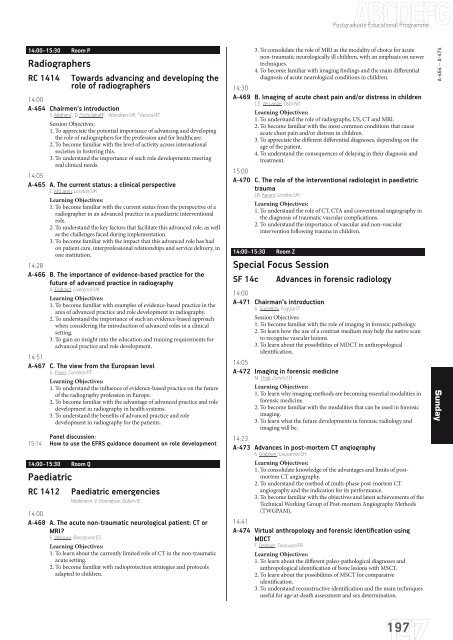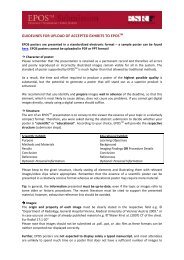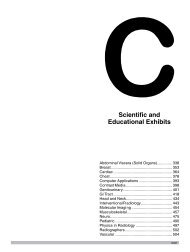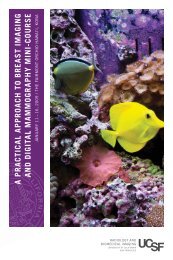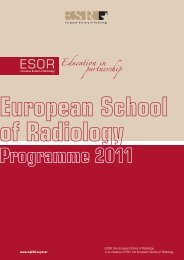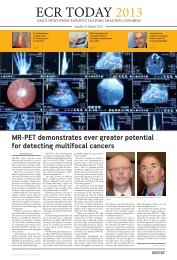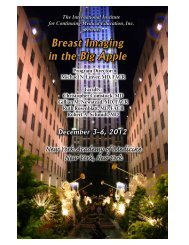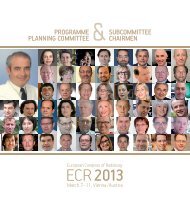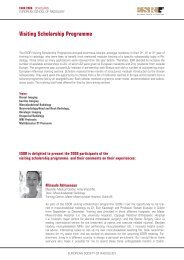ECR 2013 â Final Programme - myESR.org
ECR 2013 â Final Programme - myESR.org
ECR 2013 â Final Programme - myESR.org
- No tags were found...
Create successful ePaper yourself
Turn your PDF publications into a flip-book with our unique Google optimized e-Paper software.
Postgraduate Educational <strong>Programme</strong>14:00–15:30 Room PRadiographersRC 1414 Towards advancing and developing therole of radiographers14:00A-464 Chairmen‘s introductionS. Mathers 1 , D. Tscholakoff 2 ; 1 Aberdeen/UK, 2 Vienna/ATSession Objectives:1. To appreciate the potential importance of advancing and developingthe role of radiographers for the profession and for healthcare.2. To become familiar with the level of activity across internationalsocieties in fostering this.3. To understand the importance of such role developments meetingreal clinical needs.14:05A-465 A. The current status: a clinical perspectiveC. McLaren; London/UKLearning Objectives:1. To become familiar with the current status from the perspective of aradiographer in an advanced practice in a paediatric interventionalrole.2. To understand the key factors that facilitate this advanced role, as wellas the challenges faced during implementation.3. To become familiar with the impact that this advanced role has hadon patient care, interprofessional relationships and service delivery, inone institution.14:28A-466 B. The importance of evidence-based practice for thefuture of advanced practice in radiographyA. England; Liverpool/UKLearning Objectives:1. To become familiar with examples of evidence-based practice in thearea of advanced practice and role development in radiography.2. To understand the importance of such an evidence-based approachwhen considering the introduction of advanced roles in a clinicalsetting.3. To gain an insight into the education and training requirements foradvanced practice and role development.14:51A-467 C. The view from the European levelG. Paulo; Coimbra/PTLearning Objectives:1. To understand the influence of evidence-based practice on the futureof the radiography profession in Europe.2. To become familiar with the advantage of advanced practice and roledevelopment in radiography in health systems.3. To understand the benefits of advanced practice and roledevelopment in radiography for the patients.Panel discussion:15:14 How to use the EFRS guidance document on role development14:00–15:30 Room QPaediatricRC 1412 Paediatric emergenciesModerator: V. Donoghue; Dublin/IE14:00A-468 A. The acute non-traumatic neurological patient: CT orMRI?E. Vázquez; Barcelona/ESLearning Objectives:1. To learn about the currently limited role of CT in the non-traumaticacute setting.2. To become familiar with radioprotection strategies and protocolsadapted to children.3. To consolidate the role of MRI as the modality of choice for acutenon-traumatic neurologically ill children, with an emphasis on newertechniques.4. To become familiar with imaging findings and the main differentialdiagnosis of acute neurological conditions in children.14:30A-469 B. Imaging of acute chest pain and/or distress in childrenC.E. de Lange; Oslo/NOLearning Objectives:1. To understand the role of radiographs, US, CT and MRI.2. To become familiar with the most common conditions that causeacute chest pain and/or distress in children.3. To appreciate the different differential diagnoses, depending on theage of the patient.4. To understand the consequences of delaying in their diagnosis andtreatment.15:00A-470 C. The role of the interventional radiologist in paediatrictraumaJ.B. Karani; London/UKLearning Objectives:1. To understand the role of CT, CTA and conventional angiography inthe diagnosis of traumatic vascular complications.2. To understand the importance of vascular and non-vascularintervention following trauma in children.14:00–15:30 Room ZSpecial Focus SessionSF 14c Advances in forensic radiology14:00A-471 Chairman‘s introductionG. Guglielmi; Foggia/ITSession Objectives:1. To become familiar with the role of imaging in forensic pathology.2. To learn how the use of a contrast medium may help the native scanto recognise vascular lesions.3. To learn about the possibilities of MDCT in anthropologicalidentification.14:05A-472 Imaging in forensic medicineM. Thali; Zurich/CHLearning Objectives:1. To learn why imaging methods are becoming essential modalities inforensic medicine.2. To become familiar with the modalities that can be used in forensicimaging.3. To learn what the future developments in forensic radiology andimaging will be.14:23A-473 Advances in post-mortem CT angiographyS. Grabherr; Lausanne/CHLearning Objectives:1. To consolidate knowledge of the advantages and limits of postmortemCT angiography.2. To understand the method of multi-phase post-mortem CTangiography and the indication for its performance.3. To become familiar with the objectives and latest achievements of theTechnical Working Group of Post-mortem Angiography Methods(TWGPAM).14:41A-474 Virtual anthropology and forensic identification usingMDCTF. Dedouit; Toulouse/FRLearning Objectives:1. To learn about the different paleo-pathological diagnoses andanthropological identification of bone lesions with MSCT.2. To learn about the possibilities of MSCT for comparativeidentification.3. To understand reconstructive identification and the main techniquesuseful for age-at-death assessment and sex determination.A-464 – A-474Sunday197


